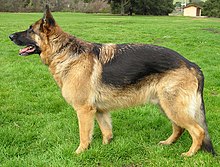
Back Ала Abkhazian Asèe ACE Хьэ ADY Hond Afrikaans Hund ALS ውሻ Amharic Waco AMI Can AN कुत्ता ANP كلب Arabic
| Dog Temporal range: Late Pleistocene (c. 14,000 yrs B.P.) to present [1]
| |
|---|---|
Domesticated
| |
| Scientific classification | |
| Domain: | Eukaryota |
| Kingdom: | Animalia |
| Phylum: | Chordata |
| Class: | Mammalia |
| Order: | Carnivora |
| Family: | Canidae |
| Genus: | Canis |
| Species: | C. familiaris
|
| Binomial name | |
| Canis familiaris | |
| Synonyms[3] | |
|
List
| |

Dogs are mammals, usually kept as pets or for work on farms or the police. Some dogs are trained to be rescue dogs and join teams such as mountain rescue.
They have been bred by humans from their ancestral wolves. They were the first animals to live with humans.[4]
There was a lot of variety among wolves in the Late Pleistocene.[1] The dingo is also a dog, but many dingos have become wild animals again and live in the wild, away from humans (parts of Australia).
Today, some dogs are used as pets, and others are used to help humans do their work. They are popular pets because they are usually playful, friendly, loyal, and listen to humans. Thirty million dogs in the United States have been registered as pets.[5] Dogs eat both meat and vegetables, often mixed together and sold in stores as dog food. Dogs often have jobs including police dogs, army dogs, assistance dogs, fire dogs, messenger dogs, hunting dogs, herding dogs, or rescue dogs.
They are sometimes called "canines" from the Latin word for dog - canis. Wolves are also canines. A baby dog is called a pup or puppy. A dog is called a puppy until it is about one year old.[6]
Dogs are sometimes known as "man's best friend" because they are kept as pets, are usually loyal, and like being around humans. Dogs like to be petted, but only when they can first see the petter's hand before petting; one should never pet a dog from behind.
August 26 is National Dog Day.[7] While March 26 is National Puppy Day.[8]
- ↑ 1.0 1.1 Thalmann, Olaf; Perri, Angela R. (2018). "Paleogenomic Inferences of Dog Domestication". In Lindqvist, C.; Rajora, O. (eds.). Paleogenomics. Population Genomics. Springer, Cham. pp. 273–306. doi:10.1007/13836_2018_27. ISBN 978-3-030-04752-8.
- ↑ Linnæus, Carl (1758). Systema naturæ per regna tria naturæ, secundum classes, ordines, genera, species, cum characteribus, differentiis, synonymis, locis. Tomus I (in Latin) (10 ed.). Laurentius Salvius. pp. 38–40. Retrieved 11 February 2017.
- ↑ Wozencraft, W. C. (2005). "Order Carnivora". In Wilson, D. E.; Reeder, D. M (eds.). Mammal Species of the World (3rd ed.). Johns Hopkins University Press. pp. 575–577. ISBN 978-0-8018-8221-0. OCLC 62265494. Wilson, Don E.; Reeder, DeeAnn M. (2005). Mammal Species of the World: A Taxonomic and Geographic Reference. JHU Press. pp. 575–577. ISBN 978-0-8018-8221-0.
- ↑ Irving-Pease, Evan K.; Ryan, Hannah; Jamieson, Alexandra; Dimopoulos, Evangelos A.; Larson, Greger; Frantz, Laurent A.F. 2018. Paleogenomics of Animal Domestication. In Lindqvist, C.; Rajora, O. (eds) Paleogenomics. Population Genomics. Springer, Cham. pp. 225–272. doi:10.1007/13836_2018_55. ISBN 978-3-030-04752-8
- ↑ Gifford, Clive; Lisa Clayden (2002). Family Flip Quiz Geography. Miles Kelly Publishing. ISBN 978-1-84236-146-7.
- ↑ "When Does My Puppy Finish Growing? How Long Do Puppies Grow?". American Kennel Club. Retrieved 2021-05-03.
- ↑ National Dog Day | Celebrating Dogs
- ↑ "NATIONAL PUPPY DAY — March 23". 23 March 2023.
© MMXXIII Rich X Search. We shall prevail. All rights reserved. Rich X Search






